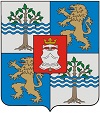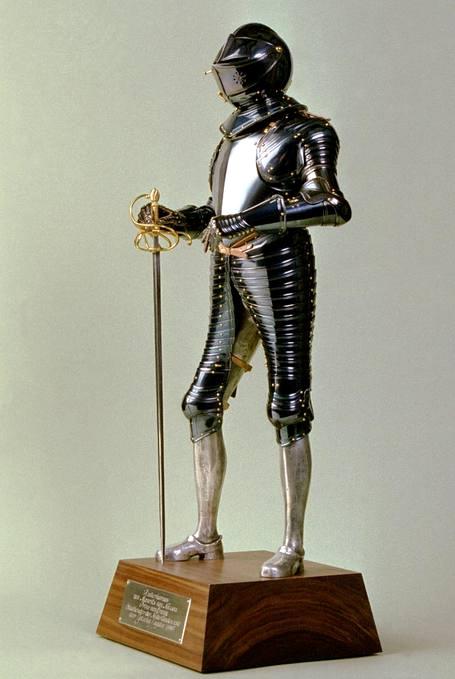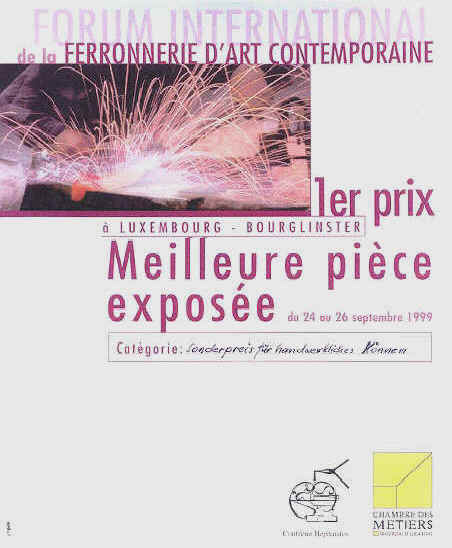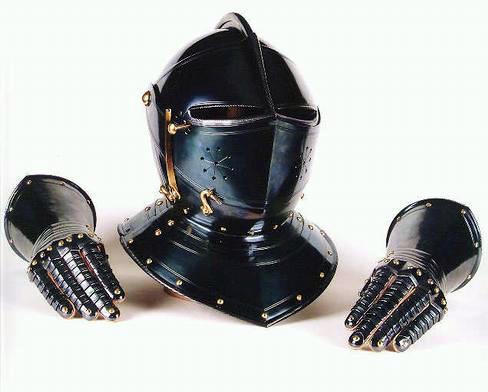I, chief
curator of the Royal Netherlands Army and Arms Museum, Delft, in short the 'Legermuseum'
wish to declare that Mr Lagidse is a smith whose work is of the highest
professional standards. I have seen and critically inspected Mr Lagidse's
product's, on the basis of which the Legermuseum in 1997 decided to entrust
him with the making of a replica of the armour of Prince Maurits of Nassau
after the original preserved at the Hofjagd- und Rüstkammer des
Kunst-historisches Museum in the Hofburg at Vienna, Austria. This replica
armour was delivered in 1999 to the Legermuseum.
The replica armour fulfilled all expectations.
It is not only exactly like the Vienna original in all respects, but since
it was decided not to artificially age it, looks much better with its even
deep-blue steel surfaces, contrasting with gilt rivets, clasps, hooks and
buckles. In fact it looks pristine enough to convey the onlooker what an
actual armour of a person of eminent status must have looked like at the
time. The armour was already shown to various interested parties and
specialists and their judgment was most favorable. It has to be seen in
reality to fully appreciate its technical execution and beauty. Even a
layman would not only sense the quality of its workmanship, but also its
cultural and historical impact.
Mr Lagidse's craftsmanship is practically unique in
Europe. To my knowledge there
are only two other persons, both active in other
countries, whose abilities and quality of their products
compare with Mr Lagidse's. As a smith, an armourer was a
craftsman with a special quality not shared by other
smiths. His craft was a combination of three basic
factors. First and foremost he should be an accomplished
smith, able to hammer cold and hot steel and mould in into
the required forms, and also be able to apply a coating
(blueing, blackening, gilding) to the steel surface by the
authentic method in using fire. Secondly, he should be
most knowledgeable on the human anatomy, because a harness
was supposed to enable the wearer to freely move about in
it and not encumber him (as the movie world seems to
suggest). While admittedly Mr Lagidse's armours are not in
principle meant to be worn, all fittings and forms should
be executed such as it intended to be used when moving,
lest the shapes and relative sizes of the armour's parts
would be unconvincing. And thirdly,
an armourer should be
well versed in, and
have a sound knowledge of, historic styles and decorative
elements, lest his products would look anachronistic and
not withstand the critical judgment of the professional
world. I am satisfied to confirm that Mr Lagidse's
craftsmanship, knowledge and artistic insight matches all
these three requirements. In fact, more is required of
him, since he must have knowledge of all styles and
ornamentation of the historic period during which armours
were worn in Western Europe, roughly 1350-1650, rather
than a contemporary armourer who had to be versed in the
style of his own age only.
Behind my statements stands a lifetime of devotion to ancient arms and
armour. This formalized in 1989 when I joined the Legermuseum in the capacity of curator of old arms and armour. The arms and armour
collection of the Legermuseum is the largest in its field in the Netherlands. It offers,
for a professional curator and scholar like myself, a source of continuous growth of
expertise. This is proven by many books and articles which I have published on these
subjects over the years. Official recognition of my status as an expert came in 1997, when
I was given the Frederiksprijs, a most prestigious award in the academic field of
historical applied arts in the Netherlands. My appointment last year as secretary general
of the International Association of Museums of arms and Military History may be considered
as proof of my international status.
An armourer, apart from having to be a
highly qualified craftsman, has to have many other qualities. He has to be well versed on
old styles of armoury and have a vast knowledge on the art of decoration, that are
completely different in the Gothic, Renaissance and Baroque periods in which such armoury
was made. I am absolutely convinces that Gotscha has
proved not only that he does have these skills and this knowledge, but that he is also
able to understand these styles as it were from the inside, and that he has the necessary
feeling for form. I am prepared to admit that these essential elements, apart from the
level of craftsmanship, also count for the so-called artist-blacksmiths, as they exist in
the Netherlands for restoration, blacksmiths work for churches and such, but even that is
not sufficient to call someone a good armourer For he has to possess an elaborate
anatomical knowledge of the human body to be able to assemble a suit of armour in the
right proportions, something which for example a sculptor also needs to possess. But, the
armourer has to know even more than the sculptor, for he also has to know the human
dynamism. Because the suit of armour has to be made in such a way, that it can be worn as
well. In other words, the separate parts should be able to move. Concerning the making of
a product which, apart from the craft itself and the knowledge of various areas, so often
calls for the interpretative capacities of the professional, the qualification
‘artist’ as well as ‘art work’ is warranted.
J.P. Puype
Chief curator of the Royal
Netherlands Army and Arms Museum
Secretary-General
of Association of Museums of Arms and Military History,
IAMAM
 Homer
Homer



.jpg)
.jpg)